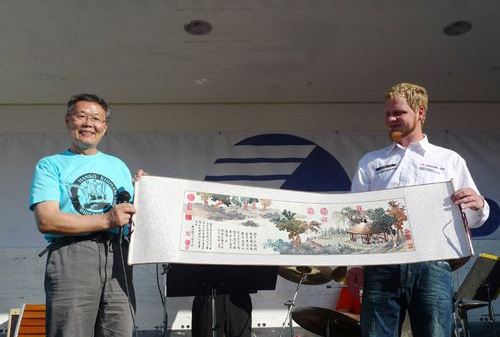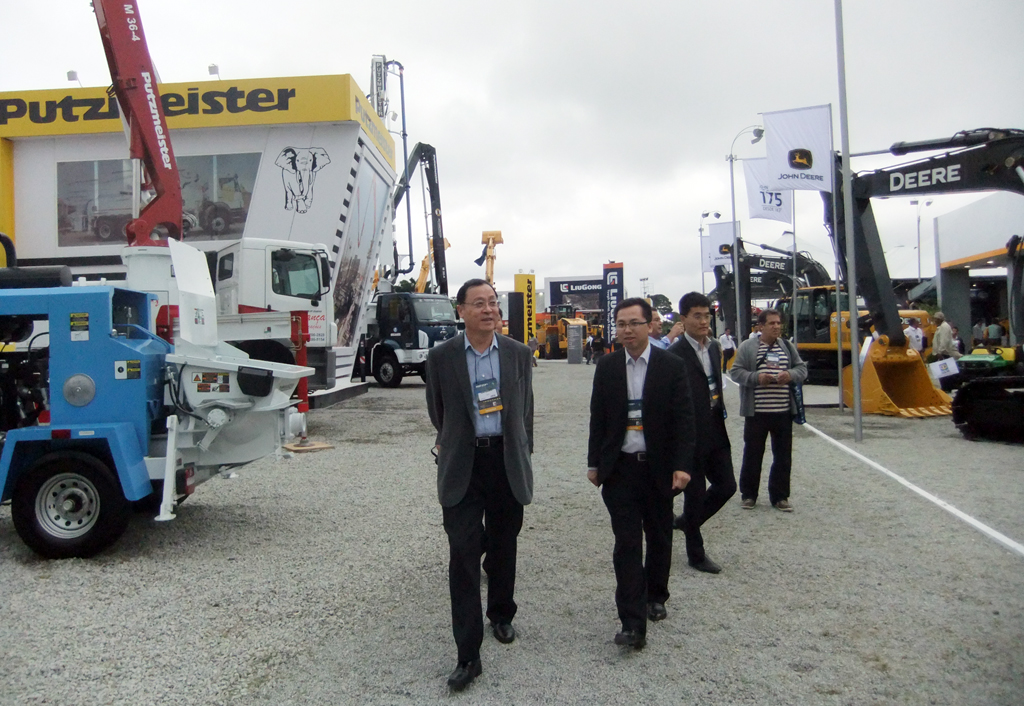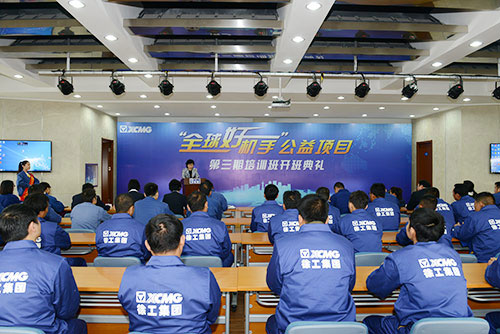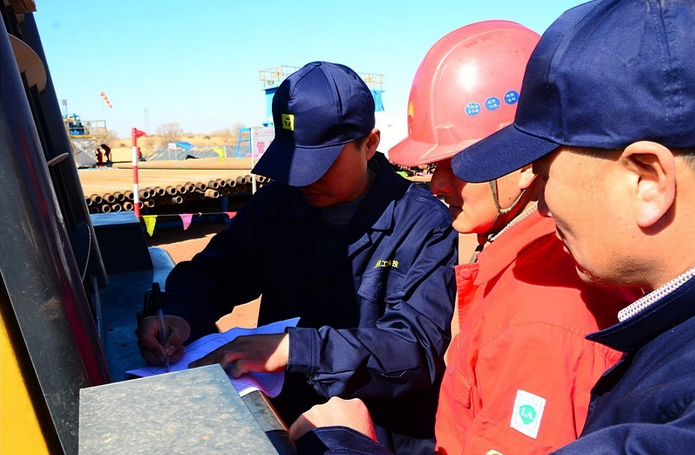June 01, 2017

Nick Tullo, sales manager, SDLG North America, good naturedly suggests that if prospective buyers of SDLG wheel loaders have difficulty recalling the sequence of letters in the name, then just remember: “these loaders sure do look good.” The suggestion might be slightly biased, admits Tullo, but he is convinced that the features, performance, and attractive retail prices of SDLG loaders do make these machines look good for certain buyers.
Actually, “SDLG” is an acronym of sorts for Shandong Lingong Construction Machinery, a Chinese manufacturer that has been marketing wheel loaders in North America since 2013, but has been building loaders since 1972 and today also offers motor graders, hydraulic excavators, backhoe loaders, and compaction rollers elsewhere in the world. According to Tullo, SDLG is the global-market leader in wheel-loader sales by volume.
In 2007, Volvo Construction Equipment purchased a 70-percent stake in SDLG, thus easing for the company what for many off-shore equipment manufacturers desiring to do business here is a tough nut to crack—competent distribution. SDLG loaders are sold and serviced by Volvo Construction Equipment dealers; not all dealers are in the fold at this point, says Tullo, but the number is increasing. The company has a parts depot in Atlanta and a machine-stocking depot near Seattle.
“When SDLG came to North America,” says Tullo, “we assumed that our toughest challenge would be counteracting a negative stereotype of Chinese equipment as being of inferior quality. As it turned out, we found that most prospective buyers recognized that China is capable of making quality products; the fundamental concern was after-sale support.”
“VALUE BRANDS” IN NORTH AMERICA
At present, SDLG offers five wheel-loader models in North America: the compact, 1-cubic-yard L918F; 2.5-cubic-yard L938F; 3-cubic-yard L948F; and 4-cubic-yard LG958L and LG959. The latter two models are identical, except the LG958L uses SDLG conventional axles with air-cooled dry-disc brakes, and the LG959 uses ZF axles with limited-slip differentials and internal wet brakes.
Alan Quinn, director, SDLG North America, sees machines such as SDLG loaders as creating a new dynamic in the marketplace.

“With the advent of so-called ‘value-brand’ equipment in North America,” says Quinn, “the buyer now has more options to consider when choosing between new and used machines. These value brands are solid, well-made pieces of equipment, but lack [some] features of premium brands, thus helping keep the price low. Value brands have gained traction with buyers in seasonal or low-hour applications and with those involved in work that simply doesn’t require premium features.”
Tullo makes the point that some buyers think value-brand machines are simply throwbacks to designs of the 1970s and ’80s, which, he says, were perfectly serviceable, but perhaps lacking some of the efficiency and intelligence of today’s models.
SDLG’s middle-of-the-line, 3-cubic-yard, 30,000-pound L948F, for example, does use some technology that was more prevalent in the past than today: a low-pressure, open-center, gear-pump hydraulic system; dry-disc brakes; no electronics (except for the engine computer); open differentials; non-automatic power-shift transmission; and externally adjusted manual kick-outs for boom and bucket.
On the other hand, the L948F uses a 171-horsepower (gross), Tier 4-Final Deutz engine with high-pressure/common-rail fuel injection and with a computer that accommodates the Volvo Tech Tool for diagnosis.Other features include pilot-operated joystick loader controls; third-function auxiliary hydraulics, complete with piping; ISO-type hydraulic quick coupler with in-cab control; and an operator’s environment that is far from bare-bones—air-conditioning, AM/FM radio, USB interface, and a large, comfortable seat. Options include ride-control, rearview camera, and high-reach boom.
The L948F has an advertised retail price of $119,500, about 30 percent less than a similar-size premium machine, says Tullo, or about the same price as a three-year-old premium loader with maybe 6,000 hours.
And the older technology? The gear-pump system doesn’t have the fine control of a closed-center, variable-displacement system, says Tullo, but 90 percent of SDLG customers’ applications, he estimates, don’t need that precision. The gear pump does cause the machine to use more fuel, he admits, but the pump is virtually bullet-proof, he says, and costs about half that of a piston pump. (The system has a main-relief pressure of 2,610 psi and a working flow of 65 gpm.)
The dry-disc brakes? Actually a positive in a way, says Tullo; they have ample stopping power, and for about $500, the machine owner can change pads all around—with wheels on and boom down.
The lack of electronics, he says, does mean, for example, that the SDLG loader doesn’t offer such features as selectable power modes or selectable hydraulic response rates, nor can it communicate full-machine status via telematics—but it can leverage the Volvo CareTrack basic package for geo-tracking. Fewer electronic systems, however, says Tullo, contribute to reliability in corrosive environments and appeals to a wide base of “do-it-yourself” customers.
Tullo sums up the company’s philosophy. “The SDLG product is aimed at being simple in design, reliable, simple to operate, and simple to maintain—all in an effort to bring down product cost without sacrificing quality.”
VALUE BRAND TO THE TEST
Having read various press releases from SDLG and reviewed spec sheets for the machines, Construction Equipment was curious about how experienced operators—those accustomed to today’s refined loaders—would react to the performance and somewhat simpler design of the SDLG loader.

We subsequently asked SDLG for the loan of a machine for evaluation, and the company shipped a new L948F to Local 649’s apprentice-training facility near Bartonville, Ill. There, on a brisk morning this past January, CE editors met up with Tullo and Local 649 instructor/operators Bill Cinnamon and Brad Walker.
Over coffee, Tullo explained a bit about SDLG’s history, the company’s approach to equipment design, its marketing strategy in North America, and the L948F’s major features. He then continued the discussion in Local 649’s new indoor operating arena, where the machine was parked, giving us a walk-around and touching on a few further design features.
“In terms of utility,” said Tullo, “SDLG tries to make the loader available with implements most contractors might need. The quick-coupler accommodates both Volvo attachments and those from several other manufacturers—including powered attachments, such as grapple buckets and brooms. A 4.5-yard light-material bucket and forks also are available.”
The L948F uses SDLG axles and a ZF 4F/3R power-shift transmission with range selection on a twist stalk and with F/N/R-selection and kick-down switches integrated into the joystick. Features that came along with the Tier 4-Final engine, said Tullo, include removal of the cab-door threshold (for easier cleaning), added sound-attenuating material in the cab, new HVAC controls, belly guards, and larger engine-compartment doors.
The available long boom, Tullo told us, adds 12 inches to the L948F’s lift height, and the company equips all machines with a heavy-duty counterweight in anticipation of customers choosing this option.
With standard boom, the L948F has a rated load capacity of just at 9,000 pounds on standard 20.5-25 bias-ply tires.
In response to Walker’s question about boom-kick-out and return-to-dig functions, Tullo pointed out the mechanical sensors on the tilt cylinder and boom cylinder that activate when the joystick is moved to its rearward or side detent position.
ASSESSING PERFORMANCE
Local 649’s property is quite large, with ample room for its crane fleet and certification testing adjacent to the training classrooms and acres of mixed terrain for apprentices to practice such skills as road building, site prep, and pipe placement. Our operators worked the SDLG loader in two locations—in a relatively flat area with stockpiles of a heavy, wet, clay/sand mixture for truck loading and for short load-and-carry runs, and in an area reserved for apprentices to practice handling pipe.
The operators alternated in the seat and among the applications, switching between the machine’s general-purpose bucket and the set of forks SDLG had sent along. Our reporting method was simple: soliciting comments from the operators as they came off the machine after various exercises, then sitting down as a group at day’s end to talk more in detail about impressions of the L948F. Perhaps the most straightforward approach here is to simply pass along in sequence the comments of the operators, and in some instances, Tullo’s responses.
Walker: It’s a very stable machine—has plenty of weight. I’m guessing that the heavy counterweight that Nick [Tullo] said SDLG uses to accommodate the long boom might be contributing to its stability.
Cinnamon: This machine would fit exactly with a contractor I worked for years ago. I realize that Nick said that in terms of utilization, SDLG is looking for that half-day user. But believe me, the contractor I worked for would buy the least expensive machine around, and then work it hard—all day, every day.
Tullo: I’ve had dealer salespeople tell me to stop saying that these machines are for low-hour use; some of their customers are using them eight to 10 hours a day. But from SDLG’s perspective, we have to look at the entire composition of the user’s fleet and how the SDLG loader typically fits in overall.
Walker: It’s not exactly a speed demon. Load-and-carry might not be the optimum application for this machine.
Tullo: Fourth gear is a bit tall, and it does take a while to get up to speed. But we’ve found that in most applications, the machine is used primarily in its two lowest speed ranges.
Cinnamon: The forks are functional with good visibility and plenty sturdy. Anytime you put forks on a loader, the issue is being able to see the tines. But on this machine, you can see what you’re doing.
Walker: It has good visibility with forks—and it is stable—I’ll give it that. The weight’s right on it. Actually, visibility from the cab generally is quite good, and I like the backup camera. The images are as clear as any I’ve seen.
Cinnamon: On the visibility issue, the addition of emissions hardware frequently increases the structure behind you, and rearward visibility has become an issue on many machines. Some machines have such monstrous engine compartments to deal with all the hardware, in fact, that there basically is no rearward visibility.
Tullo: SDLG makes an effort to keep rear visibility acceptable, but that’s becoming more difficult, because the vertical-height regulation and test procedures have become more stringent.
Walker: The stability and balance of the machine are very good. Nick keeps pushing the four-hours-per day thing, but we’ve spent eight to 10 hours on machines a lot less comfortable than this.
Cinnamon: I agree with Brad. Some contractors are going to use the machine as a primary unit, but even if the machine is used in a low-hour application, I think SDLG has hit a niche in the market. It’s going to be a valuable machine for the user who’s looking for this sort of equipment. But, of course, some users will demand more from a machine than a low-hour user might expect.
Walker: At one point, I heaped the bucket with that heavy sand material, raised the boom to full height, and brought it down quickly, catching the load at about mid-height. I expected to get some bounce or have the machine get light in the back, but it remained very stable. Also tried loading from the stockpile at an angle, but this didn’t seem to affect stability. And there was no wheel spin going into the pile—I put my foot into it in second gear and couldn’t make it spin. Maintaining traction is a big plus for loaders.
Cinnamon: The stability was there—not much difference, really, whether the bucket was empty or loaded.
Walker: The hydraulics were fast enough, in my opinion. I did notice, as Nick told us, that the controls aren’t quite as responsive as in a premium machine, but that’s something you can adapt to and control. I could hear the gear pump whining a bit, but that’s just the nature of the pump. Overall, the power of the hydraulics is fine. We were working in very heavy, wet material, but there was never a problem getting a full load. I’d like to try the machine with a powered attachment to see how the auxiliary system works.
Cinnamon: I concur—there’s really nothing negative I could say about the overall hydraulic-system performance of the machine. It matches well with many of the machines of the same type I’ve run over the years. The [hydraulic] response is fine. I think you do have to make a conscious effort to keep the rpm up in a gear-pump system, but that’s just the way it works. You usually have the throttle all the way up, so it’s not a detriment. You might on occasion have an operator who’s not quite willing to tromp on the throttle, but that’s the only time I could see this as being an issue.
Cinnamon: The cab was tight and quiet. Going beyond that, the layout of the controls was easy to deal with and functional—everything you needed was at hand and easy to understand.
Cinnamon: The coupler worked well, and I liked being able to see that the pins were engaged. There’s not a lot of ancillary stuff in the way to obscure your view to the attachment.
Tullo: It’s our intent to add pin indicators.
Walker: I like the maintenance aspects of the machine—the brakes are easy to service, all the routine service points are on one side, and the remote drain lines are positioned so they’re not going to get snagged on rock or debris.
Walker: The only drawback I saw with this machine is its travel speed. If you’re supporting a pipe crew on a job that might not be staged just right, and you have to run a block to get sand, then the machine might be a bit slow. Other than that, it seems a good machine—solid.
C.E.: If you wanted to use this machine all day, every day, do you think it has the capability to handle that?
Cinnamon: Absolutely. I’m fond of machines like this. I don’t know if that’s due to my age, but sometimes, simpler is better—not having to deal with so many bells and whistles. Just get in the machine and go to work.

At 6:00 pm on 29th June, a SWE17B excavator with provisional license plate appeared, the waiting cro

May 29 ~ June 2, the M&T EXPO was held at Immigrants Exhibition Center in St. Paul, Brazil. During the exhibition, Shandong Lingong exh

On November 7, the opening ceremony for Phase III Training of XCMG Public Welfare Project -- "Global Excellent Operator" was held in XCMG, where Li Ge, the Deputy Secreta

What is breaking force deficiency? It is when you press the brake pedal down, the loader does not slow down or stop as required. The main causes include: ① The brake system i
Copyright Notice 2002-2025 global-ce.com Construction Machinery Online. All rights reserved.
Address: Room 901, Building C, Ruipu Mansion, Hongjunying South Road No.15, Chaoyang District, Beijing.100107 P.R.China